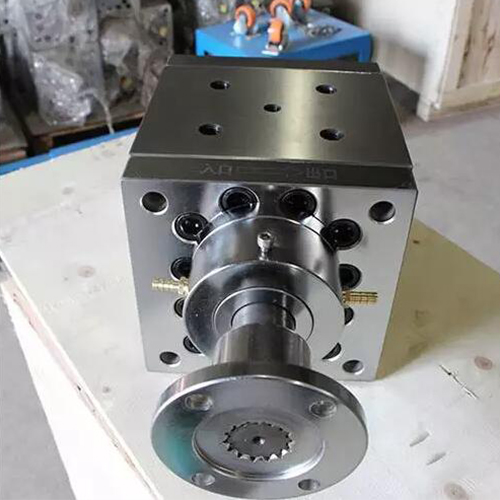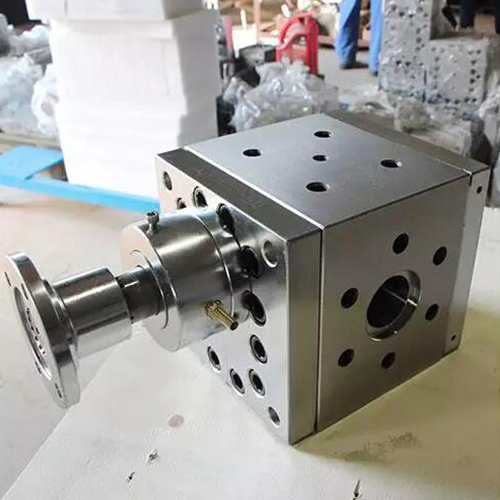
Choosing a melt pump suitable for PVC granulation production line requires comprehensive consideration of multiple factors. The following are some specific selection points:
1、 Traffic parameters:
Production demand: Clarify the production capacity requirements of the PVC granulation production line, and determine the flow range of the melt pump based on the required PVC particle production per hour or per day. The flow rate of the melt pump should match the overall production speed of the production line to ensure timely and stable material transportation. For example, if the production line needs to process 1 ton of PVC material per hour, the selected melt pump flow rate should be able to meet this demand.
Speed regulation: Consider the range and method of speed regulation for the melt pump. Generally speaking, the use of variable frequency speed regulation for melt pumps can better achieve precise control of flow rate, and can flexibly adjust the speed according to the actual needs of the production line to adapt to different production conditions.

2、 Pressure parameters:
Inlet pressure: The inlet pressure of the melt pump does not need to be too high, generally 3-5 MPa is sufficient, but for high viscosity PVC melt, a slightly higher inlet pressure may be required to ensure that the material can enter the pump body smoothly. The appropriate inlet pressure range should be determined based on factors such as the output pressure of upstream equipment (such as extruders) and the installation position of the melt pump.
Export pressure: The export pressure depends on the pressure requirements of subsequent process equipment (such as extruder heads, molds, etc.) in the granulation production line. To ensure that the outlet pressure of the melt pump can meet the needs of smoothly transporting PVC melt to the next stage, and to consider the possible pressure fluctuations under different production conditions, a melt pump with sufficient pressure stability should be selected.
Pressure difference: Pressure difference is the difference between the inlet pressure and outlet pressure of the melt pump, which reflects the pressure building capacity of the melt pump. For PVC granulation production lines, it is necessary to choose a suitable melt pump with a pressure difference based on the required pressure increase during the actual production process. Generally, melt pumps with a pressure difference of around 20-30 MPa can meet the needs of most PVC granulation production.
3、 Temperature parameters:
Working temperature range: PVC is a thermosensitive material that is sensitive to temperature changes during processing. Therefore, the selected melt pump should have a temperature range suitable for PVC processing. Usually, the working temperature of the melt pump should be able to reach the processing temperature of PVC melt (usually between 150 ℃ -200 ℃), and it should have good temperature control and stability to prevent PVC material from decomposing, carbonizing and other problems due to high or low temperature during transportation.
Heating methods: Common heating methods for melt pumps include electric heating and fluid heating (such as hot oil heating). The electric heating method has the advantages of fast heating speed and precise temperature control, and is suitable for small or PVC granulation production lines with high temperature control requirements; The fluid heating method is suitable for large production lines or situations that require high heating uniformity. Choose the appropriate heating method based on the actual situation of the production line.

4、 Structure and Design:
Gear structure: Gears are the core components of the melt pump, and their structure and parameters directly affect the performance of the melt pump. For PVC melt, it is recommended to choose a melt pump with optimized tooth profile design, such as involute spur or helical gear pumps, which can provide more stable transportation and lower shear stress, reducing mechanical damage to PVC materials.
Flow channel design: The flow channel should be designed reasonably without dead corners to avoid PVC material residue and accumulation in the pump body, which may affect the performance and service life of the melt pump. At the same time, the inner diameter and shape of the flow channel should be adapted to the viscosity and flowability of the PVC material to ensure that the material can pass smoothly through the melt pump.
Sealing performance: Due to the corrosiveness and viscosity of PVC melt, the sealing performance of the melt pump is crucial. Choosing a melt pump with good sealing performance, such as using packing seals, mechanical seals, or spiral seals, can effectively prevent PVC melt leakage and facilitate maintenance and replacement of seals.
5、 Material selection:
Pump body material: The pump body should be made of high-temperature resistant, corrosion-resistant, high-strength alloy tool steel or other special alloy steel materials to ensure that the melt pump has sufficient strength and stability in high-temperature and high-pressure working environments. For PVC granulation production lines, compatibility between pump body materials and PVC materials should also be considered to avoid chemical reactions or corrosion.
Gear material: Gears are usually made of materials such as nitriding steel and high-temperature tool steel, and undergo surface hardening treatment to improve their wear resistance and fatigue resistance. For PVC materials with high filling or containing special additives, it may be necessary to choose gear materials with higher hardness and wear resistance.
Email: info@battemachinery.com
WhatsApp: +86 158 38331071